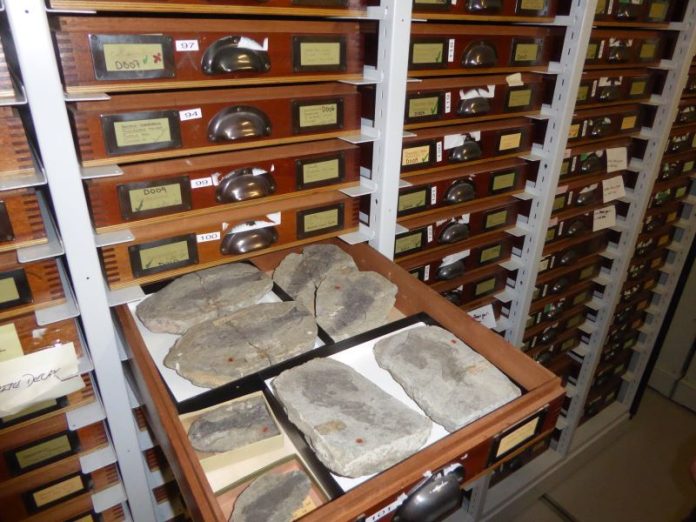
Fossil clues to life on land tell a dramatic story written not in words, but in ancient stone. Long before humans or even dinosaurs walked the Earth, fish were already beginning an incredible transformation. From the armored giants of the Devonian seas to lobe-finned pioneers like Tiktaalik, the fossil record preserves the evidence of one of evolution’s greatest leaps: the move from water to land. These fossil fish—discovered in places like Scotland, Canada, and Poland—offer glimpses of how fins slowly became limbs, gills gave way to lungs, and fish became the first true tetrapods.
From Fins to Feet: Fossil Clues in the Devonian Seas
It all begins with fish. Lots and lots of fish left fossil clues to life on land. The oldest fish fossils found so far (Haikouichthys in China and Metaspriggina in Canada) date back 518 million years to the Cambrian period and looked more like little worms. Over the remainder of the Cambrian, Ordovician and Silurian periods, they gradually grew larger and somewhat more diverse, but it wasn’t until the Devonian period (419 to 359 million years ago) that fish evolution took off. The Devonian is informally referred to as the “Age of Fishes” because of the great variety that appeared at that time. While some remained small, others like Dunkleosteus grew into fearsome armor-plated monsters as long as 16 to 33 feet, per disputed estimates.
As most fish perfected finning their way swiftly through water, others slowly modified their fins, transforming them into what are referred to as “lobe fins” featuring muscular buds that looked like stumpy little arms and legs anchoring fins to the body. Still others dubbed lungfish were modifying how they took in oxygen, using not only gills but primitive lungs evolved from air or swim bladders originally intended for buoyancy control. While this was happening in the water, up on land, plants were covering major swaths for the first time, accompanied by a thriving arthropod community and creating a beckoning Eden for any fish brave enough to enter the garden.
Amphibians Lead the Way to Life on Land
The chain of events leading from fish to humans required one key link: creatures evolved to live both in water and on land, namely, amphibians. “Amphibious” means “combining two characteristics.” It’s from the Greek word amphibion, meaning “living a double life” or “living on both sides.” Most amphibians go through an aquatic phase, with fish-like gills, then grow into air-breathing adults that can live on land. Most contemporary amphibians, as represented by frogs, toads, newts and salamanders, have broad heads, short limbs, and long, fishlike tails. With frogs and toads, tails are absent at adulthood but were present in the tadpole stage.
While you may have to look hard in damp, dark nooks to find an amphibian today, they were the dominant vertebrates on land when swamps covered large parts of Earth during the Carboniferous period (359-299 mya) and on into the Permian period (299-252 mya). Some of these early amphibians grew larger than today’s crocodiles and may have been just as fierce. But before they achieved that position, a fish had to get its legs. And that took place during the Devonian.
Act One: The Lobe-Finned Fish Take the Stage
According to a script written not so very long ago, the drama involved a simple four-act play: fish leads to “fishibian” leads to amphibious “stem-tetrapod” leads to full landfall. A handful of key actors occupied the limelight on stage starting 385 million years ago with a fish named Eusthenopteron. This fish still possessed a bunch of fins on its back, belly and tail, but it was a lobe-finned fish, meaning the fins were anchored by muscular proto-limb buds within the fins, as seen in the coelacanths of today. Osteolepis was another lobe-finned fish belonging to the Crossopterygians, or the group believed to have given rise to tetrapods. These and many other Devonian fish have been uncovered in deposits within Scotland, the Canadian Maritimes, and the state of Pennsylvania.
Tiktaalik: The Star of the Shallows
By 375 million years ago, a scaly 4-foot-long “fishapod” or “fishibian” named Tiktaalik awkwardly flopped onto the stage, occupying a freshwater delta environment that emptied into an inland sea. Based on fossil clues to life on land, bone found in a remote corner of the Canadian Arctic, Tiktaalik had lost all fins along its belly, back, and sides except for four situated right where amphibians today have limbs. Within those four fins were the clear, if stubby, beginnings of elbow, wrist, and finger bones. Rather than being useful for walking firmly on land, though, it’s believed these assisted Tiktaalik in a slow paddle and crawl along muddy bottoms of shallow murky waters where it occasionally surfaced to gulp a breath of air into primitive lungs that supplemented its gills. This would have proved helpful given that warm shallow waters tend to be low in oxygen content, thus nudging fuller development of air-breathing lungs. When first discovered, the popular press immediately proclaimed it the missing link between the fossil fish of 385 million years ago and 4-legged amphibians that would soon appear.
From Flippers to Feet: Tetrapods Emerge
And appear they did. By the Late Devonian (365 million years ago), two new actors strode onto the stage, per fossils found in East Greenland. Acanthostega and Ichthyostega had four fully developed limbs tipped in digits (not fins) and could breathe well both on land and in water through a dual system of gills and lungs. They were widely considered the earliest definitive tetrapods: four-footed amphibians that had completed the water-to-land transition. However, the more they’ve studied them, the more paleontologists have come to believe they remained tethered to an aquatic lifestyle, with webbed feet that would have been more comfortable moving heavy bodies about in weed-choked shallows rather than on land. For this reason, they’re often referred to as stem-tetrapods even though they did seem capable of flopping onto land, if in a reluctant and cumbersome manner.
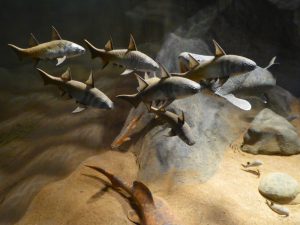
Romer’s Gap: Fossil Clues to Life on Land, the Missing Chapter
The Devonian period closed 359 million years ago with a great extinction dubbed the Hangenberg Event, which killed off many would-be tetrapods in their tracks. And when it comes to further developments in the tetrapod journey, the earliest days of the subsequent Carboniferous period are obscured by the mysterious Romer’s Gap. (Every good drama requires a mystery!) Few if any tetrapod fossils seemed to be on stage from 360 to 345 million years ago. Thus, it was widely believed that Romer’s Gap (named for Harvard paleontologist Alfred Sherwood Romer) was a time of low oxygen levels that constrained tetrapods as they attempted their landward evolution.
But life evolved, as evidenced by fossil clues to life on land left by tetrapods discovered in Scotland during the very period of Romer’s Gap, fossils that would seemingly belie the hypothesis that low oxygen levels were prevalent at the time. As the land became increasingly lush with plants, our four-act play finally saw the arrival of fully land-dwelling tetrapods, including a foot-long temnospondyl named Balanerpeton, discovered in the East Lothian region of Scotland. Self-taught field paleontologist Stan Wood played a key role in the 1980s with significant discoveries in Scotland’s East Kirkton Quarry of West Lothian in rocks indicative of a hot spring environment. Balanerpeton was accompanied by others from East Kirkton and elsewhere in Scotland and given fun names like “Tiny” and “Ribbo” and, perhaps most famous of all, “Lizzie” (Westlothiana lizziae), which some think may be the world’s first lizard. Far from being empty, Romer’s Gap was actually chock-full of diverse tetrapods that soon crowded the stage with all manner of four-legged creatures walking the land. Tetrapods had arrived.
Where to Find Fossil Clues to Life on Land: Evidence of the First Tetrapods
So, fossil clues to life on land are pretty straightforward, right? Then explain this. If the first stem-tetrapods hit land “only” 365 million years ago and the first full-scale tetrapods some 20 million years later, how is it we appear to have very large tetrapod footprints dated 395 million years ago? Poland, it seems, lobbed a hand grenade onto the stage with the discovery of the Zachelmie trackways. Similar 384-million-year-old fossil tracks have surfaced in Ireland, as well. Both suggest critters that emerged from water on four solid feet, perhaps to scavenge stranded fish & other food on tidal flats. Although no bones have been discovered to give us a view of their anatomy, the footprints and trackways suggest that sure-footed tetrapods emerged far earlier than previously thought.
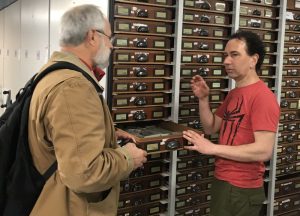
Modern DNA Meets Ancient Fossil Clues to Life on Land
Forget bones! Genomic analyses and comparisons of living fish and tetrapods provide evidence suggesting how and when different critters may have diverged from a common ancestor. Just like those Polish footprints are fossil clues to life on land, genetic analyses indicate that tetrapods should go much further back than thought. One study using molecular data from proteins of 17 species suggests tetrapods extend back as far as 397-416 million years. Yet another group of researchers used mathematical modeling combined with molecular information and data from body fossils and footprints to determine that tetrapods diverged from fish 390 million years ago. Such research, along with those footprints in Poland, suggests far older bones are out there than have been uncovered to date.
When attempting to pull back the curtain on a play involving very few fossil clues to life on land, all it takes is one new actor to upset the applecart and send the scriptwriters back to their desks. So it is in dealing with the evolution of the tetrapods. The move from water to land remains fuzzy. And should we be surprised? After all, we’re looking at events taking place hundreds of millions of years ago and fossil clues to life on land are fragmentary at best. With each new fossil discovery (and now with each new genomic analysis), the story is not just filled in; it sometimes requires a rewrite. Because tetrapods were well along on their way in the Late Devonian period, it is indeed likely they were already evolving in the Early Devonian, as those Polish and Irish footprints and DNA studies suggest.
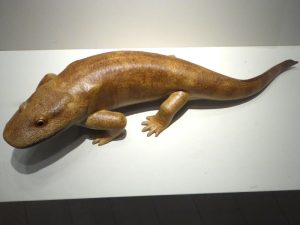
Weird Fossils, Weirder Names: A Cast of Prehistoric Stars
A hit parade of some key actors in the march onto land.
- Lobed-finned fish inhabiting water: Osteolepis and Eusthenopteron
- “Fishibians” or “fishopods” with limb-like fins: Tiktaalik
- “Stem-tetrapods” achieving tenuous landfall: Acanthostega and Ichthyostega
- Full-fledged tetrapods taking to the land: Balanerpeton and Casineria
Fossils Without Borders: Global Sources of Tetrapod Clues
Tetrapod ancestors that left behind fossil clues to life on land ranged widely around the globe, as suggested by these examples of key localities. (Bear in mind some of these far-flung countries were neighbors during the Devonian.)
- Scotland
- Poland
- Greenland
- Canada
- United States (Pennsylvania)
- Russia
- China
- Australia
- South Africa
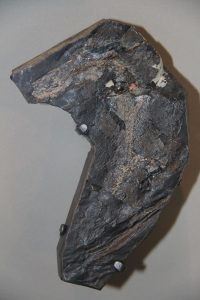
No Turning Back: Tetrapods Take Over the Land
Whenever they evolved, “fishibians” and the earliest tetrapods ignited an evolutionary explosion that saw all manner of amphibians stride confidently across a newly crowded stage early in the Carboniferous Period. While key links like Tiktaalik are rare, later amphibians became so common you can often find their fossilized remains from the Carboniferous and Permian periods for sale in relative abundance. They would diversify into primarily land-dwelling reptiles, dinosaurs, birds, and mammals. Some, like mosasaurs and whales, would return to the water, but they would retain their need to breathe air and the vestigial remains of four legs.
Fossil Clues to Life on Land: Final Thoughts
Because the fossil record is fragmentary with fossil clues to life on land, this is an area of research sorely in need of more actors to fill the stage and more writers to help shape a script as exciting as life itself. So why are you sitting around reading this? The right actor is out there. The casting director is waiting. Like Stan Wood did in Scotland, dig deep and look!
This story about fossil clues to life on land previously appeared in Rock & Gem magazine. Click here to subscribe. Story and photos by Jim Brace-Thompson.















